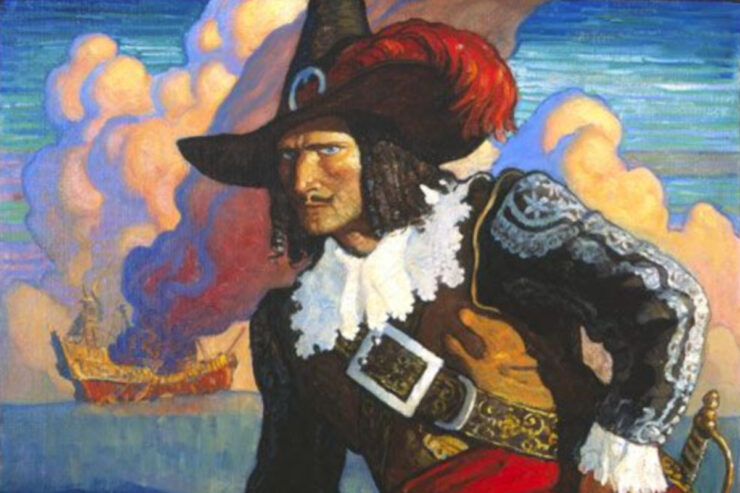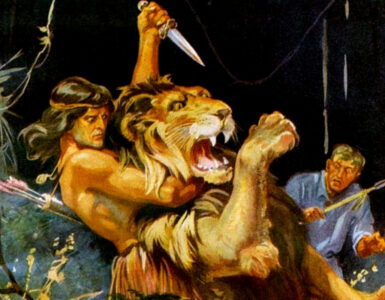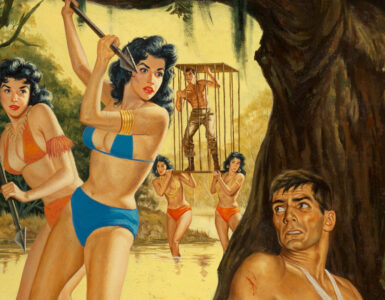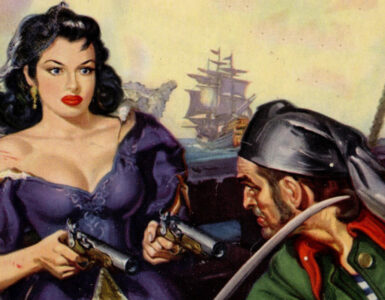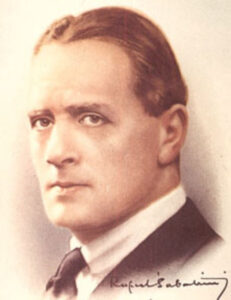 Bookending the month of April with Edgar Wallace, Rafael Sabatini was born on April 29, 1875. This year marks the 150th anniversary of his birth.
Bookending the month of April with Edgar Wallace, Rafael Sabatini was born on April 29, 1875. This year marks the 150th anniversary of his birth.
Both his parents were well-known opera singers, performing throughout the world. Sabatini’s mother was English, while his father was Italian. They met while appearing in Manila and soon married. Sabatini was born in the small town of Jesi, Italy, where his paternal grandfather lived.
While his parents continued touring, their young son lived with his English grandparents near Liverpool.
At age seven, the boy rejoined his parents in Portugal, where they had opened a school for voice. Enrolled in a nearby Catholic school, the young Sabatini learned more languages, including Portuguese and Latin. He would pick up French and German after being shipped off to Switzerland to continue his schooling.
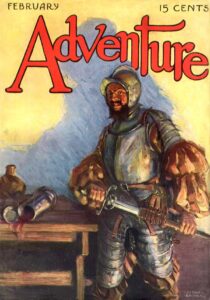 From an early age, Rafael Sabatini was a voracious reader. In later years, he told a publicist: “Before I first left England at seven, I read — but if I were to tell you what I had read, you would not believe me.” Although he enjoyed Cervantes, Alexandre Dumas, Alessandro Manzoni, Friedrich Schiller, and Jules Verne, his favorites were Stanley John Weyman — a writer of historical romances — and the American historian William H. Prescott, author of History of the Conquest of Mexico and History of the Conquest of Peru.
From an early age, Rafael Sabatini was a voracious reader. In later years, he told a publicist: “Before I first left England at seven, I read — but if I were to tell you what I had read, you would not believe me.” Although he enjoyed Cervantes, Alexandre Dumas, Alessandro Manzoni, Friedrich Schiller, and Jules Verne, his favorites were Stanley John Weyman — a writer of historical romances — and the American historian William H. Prescott, author of History of the Conquest of Mexico and History of the Conquest of Peru.
His formal schooling ended at seventeen. Afterward, Sabatini returned to Liverpool and found employment as a translator in the Brazilian coffee trade. His work left him time for reading, and he began to dabble with the pen, placing some of his first efforts with local newspapers and journals. In 1898, he made his first sale to a cheap competitor of The Strand Magazine. “The Red Mask” — a story of intrigue and treachery that concerns Cardinal Mazarin, a Roman Catholic prelate, diplomat, and politician who served as the chief minister to Louis XIII and Louis XIV — appeared in the December 1898 issue of The Ludgate.
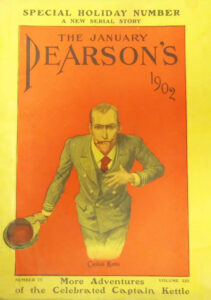 As the century turned, Sabatini was regularly selling to better-paying periodicals, including London Magazine, Pearson’s Magazine, and The Royal Magazine in England, and Ainslee’s Magazine in the United States. His first novel, “The Lovers of Yvonne” was serialized in 1902 by Short Stories, a British weekly. In the United States, it ran in the American edition of Pearson’s Magazine, appearing in six monthly issues in early 1902.
As the century turned, Sabatini was regularly selling to better-paying periodicals, including London Magazine, Pearson’s Magazine, and The Royal Magazine in England, and Ainslee’s Magazine in the United States. His first novel, “The Lovers of Yvonne” was serialized in 1902 by Short Stories, a British weekly. In the United States, it ran in the American edition of Pearson’s Magazine, appearing in six monthly issues in early 1902.
As his work grew in popularity, Sabatini placed stories with The Grand Magazine, The Pall Mall Magazine, The Premier Magazine, The Story-teller, The Strand, and other magazines in England. Readers in the United States could find him in Adventure, The American Magazine, The Cavalier, Cosmopolitan, Munsey’s Magazine, The Red Book Magazine, Top-Notch Magazine, and other periodicals.
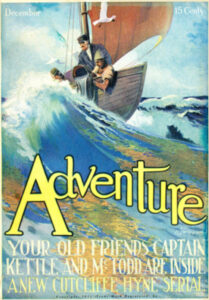 At home writing about the Italian Renaissance, the Spanish Inquisition, England during the reigns of Charles II and the early Georges, revolutionary France, and his own time, Sabatini not only turned out historical fiction, but also tales of revenge, tricksters and con artists, highwaymen, murder mysteries, and more. For The Premier Magazine, he penned twenty “Historical Nights’ Entertainments,” stories that blended factual history with imaginative storytelling, showcasing notable figures and events drawn from the historical record.
At home writing about the Italian Renaissance, the Spanish Inquisition, England during the reigns of Charles II and the early Georges, revolutionary France, and his own time, Sabatini not only turned out historical fiction, but also tales of revenge, tricksters and con artists, highwaymen, murder mysteries, and more. For The Premier Magazine, he penned twenty “Historical Nights’ Entertainments,” stories that blended factual history with imaginative storytelling, showcasing notable figures and events drawn from the historical record.
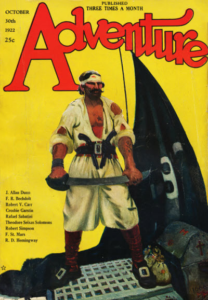 After his second book, The Tavern Knight, was published in 1905, Rafael Sabatini started writing full-time. Blessed with a loyal but not very large readership, he continued turning out short stories and novellas for the periodical market while publishing a new novel just about every year. His work from this period included his series regarding the life and times of the priest-turned-mercenary Cesare Borgia, The Sea Hawk — set in Cornwall and the Barbary Coast — two volumes of the aforementioned Historical Nights’ Entertainment, and more. On top of all this, he served as a translator for British Intelligence during the First World War.
After his second book, The Tavern Knight, was published in 1905, Rafael Sabatini started writing full-time. Blessed with a loyal but not very large readership, he continued turning out short stories and novellas for the periodical market while publishing a new novel just about every year. His work from this period included his series regarding the life and times of the priest-turned-mercenary Cesare Borgia, The Sea Hawk — set in Cornwall and the Barbary Coast — two volumes of the aforementioned Historical Nights’ Entertainment, and more. On top of all this, he served as a translator for British Intelligence during the First World War.
Following the end of the Great War, Sabatini released the two works that brought him fame and fortune. The first of the two — “Scaramouche” — was serialized over eleven months by Hutchinson & Co. in The Sovereign Magazine, beginning with the November 1920 issue. Set during the French Revolution, Sabatini’s story concerns a young lawyer who becomes an orator, an actor and playwright, a politician, and a fencing master. He gains “. . . fame and happiness because he fought equally well with tongue and rapier.” The first hardcover edition was released in 1921 by Houghton Mifflin Company.
 One month after the start of the serialization of “Scaramouche,” Sabatini began a series of nine stories that he’d later adapt into the second of his bestselling novels. “The Rebel Convicts” — the first of his Captain Peter Blood tales — appeared in The Premier Magazine, dated December 3, 1920. It was followed by an appearance in Adventure magazine about six months later. The final yarn in the series — a novelette entitled “Governor Blood” — ran in The Premier Magazine for April 22, 1921, and in the October 20 issue of Adventure that same year as “Captain Blood’s Dilemma.”
One month after the start of the serialization of “Scaramouche,” Sabatini began a series of nine stories that he’d later adapt into the second of his bestselling novels. “The Rebel Convicts” — the first of his Captain Peter Blood tales — appeared in The Premier Magazine, dated December 3, 1920. It was followed by an appearance in Adventure magazine about six months later. The final yarn in the series — a novelette entitled “Governor Blood” — ran in The Premier Magazine for April 22, 1921, and in the October 20 issue of Adventure that same year as “Captain Blood’s Dilemma.”
Although a work of fiction, Captain Blood: His Odyssey — published by Houghton Mifflin Company in 1922 — was based on the true story of a surgeon who had cared for the wounded who had rebelled against James II. Transported to Barbados to work on a plantation, the doctor was captured by pirates. Sabatini’s novel also owed a debt to Alexandre Exquemelin, the confidante of Sir Henry Morgan, the Welsh privateer who later served as the Lieutenant Governor of Jamaica. Exquemelin later wrote a book about his adventures with Morgan and the buccaneers of the Caribbean.
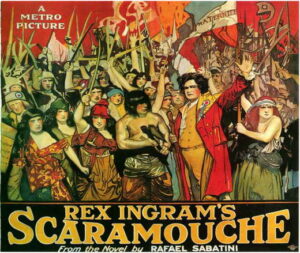 Scaramouche and Captain Blood proved to be great successes, both in England and the United States. His publishers quickly rushed Sabatini’s early books — including The Sea Hawk — back into print. Arthur Sullivant Hoffman also serialized the latter in Adventure over five issues published in October and November 1922.
Scaramouche and Captain Blood proved to be great successes, both in England and the United States. His publishers quickly rushed Sabatini’s early books — including The Sea Hawk — back into print. Arthur Sullivant Hoffman also serialized the latter in Adventure over five issues published in October and November 1922.
In 1922, Scaramouche was adapted to film by Rex Ingram, while Captain Blood and The Sea Hawk received a similar treatment in 1924. Sabatini’s 1906 novel of love, intrigue, and adventure, Bardelys the Magnificent, got the big screen treatment in 1926. Directed by King Vidor, the film featured a 19-year-old John Wayne in a bit part. After writing for nearly thirty years, Rafael Sabatini had become famous and fabulously wealthy.
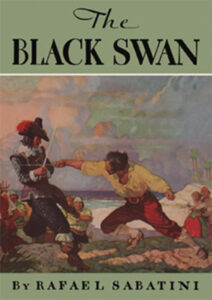 Despite his fame and fortune, Sabatini loved to tell stories and continued to write for the rest of his life. Bellarion the Fortunate, set during the Italian Renaissance and one of his finest works, appeared in 1926, while his novel of the Spanish Inquisition, The Hound of God, appeared two years later. Scaramouche the Kingmaker and Captain Blood Returns — the sequels to his two great successes — were published in 1931, while The Black Swan, another Caribbean pirate adventure, set sail one year later. Chivalry, the story of a pre-Renaissance Italian mercenary that features four strong women characters, was published in 1935, while Sabatini closed out the history of Peter Blood with The Fortunes of Captain Blood in 1936. A third volume collecting the author’s “Historical Nights’ Entertainments” appeared in 1938.
Despite his fame and fortune, Sabatini loved to tell stories and continued to write for the rest of his life. Bellarion the Fortunate, set during the Italian Renaissance and one of his finest works, appeared in 1926, while his novel of the Spanish Inquisition, The Hound of God, appeared two years later. Scaramouche the Kingmaker and Captain Blood Returns — the sequels to his two great successes — were published in 1931, while The Black Swan, another Caribbean pirate adventure, set sail one year later. Chivalry, the story of a pre-Renaissance Italian mercenary that features four strong women characters, was published in 1935, while Sabatini closed out the history of Peter Blood with The Fortunes of Captain Blood in 1936. A third volume collecting the author’s “Historical Nights’ Entertainments” appeared in 1938.
At the dawn of the Second World War, Sabatini developed stomach cancer. Still, he wanted to continue writing, and in 1941 his romantic version of the life of Christopher Columbus was published. Three years later came King in Prussia, a novel exploring the early life of Frederick the Great. His last novel — published in 1949 — was The Gamester, a historical adventure novel revolving around the Scottish financier John Law.
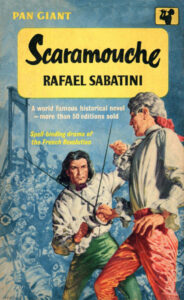 Sabatini died on February 13, 1950. All told, he published 34 novels, eight short story collections, six non-fiction books, numerous uncollected short stories, and several plays. His work continues to inspire, from George MacDonald Fraser’s popular Flashman novels to Disney’s Pirates of the Caribbean and the forthcoming pirate-themed electronic game, Captain Blood.
Sabatini died on February 13, 1950. All told, he published 34 novels, eight short story collections, six non-fiction books, numerous uncollected short stories, and several plays. His work continues to inspire, from George MacDonald Fraser’s popular Flashman novels to Disney’s Pirates of the Caribbean and the forthcoming pirate-themed electronic game, Captain Blood.
Although his work was historically accurate, Rafael Sabatini was certainly a “Master of Blood and Thunder.”
“He was born with a gift of laughter and a sense that the world was mad.”
On Wednesday evening, August 6, at PulpFest 2025, we’ll have a showing of Frank Lloyd’s classic 1924 film adaptation of Rafael Sabatini’s The Sea Hawk. Here’s a YouTube trailer for Lloyd’s film, created for the Niles Film Museum by Jon C. Mirsalis.
Our featured image is excerpted from N. C. Wyeth’s dust jacket for the first American edition of Rafael Sabatini’s Captain Blood, published by Houghton Mifflin in 1922. It was the tremendous success of Captain Blood and Scaramouche that made Sabatini into a household name.
Our lead image is a portrait of Rafael Sabatini by an unknown photographer, used for a color offset lithographic cigarette card created for Will’s Cigarettes in 1937. The original is in London’s National Portrait Gallery.
One of Sabatini’s favorite writers was the American historian William H. Prescott, author of History of the Conquest of Mexico and History of the Conquest of Peru. The author admitted that he sometimes daydreamed that he was a conquistador, such as the one pictured on Arthur E. Beecher’s cover for the February 1913 issue of Adventure. Born in Germany, Beecher was an illustrator of books and magazines and a fine art painter known for landscapes and historical scenes. He trained in Munich and with Howard Pyle of the Brandywine School.
Rafael Sabatini’s first novel, “The Suitors of Yvonne,” was serialized in six parts in the US edition of Pearson’s, beginning with the January 1902 number. The cover art is by Stanley L. Wood, depicting C. J. Cutcliffe Hyne’s Captain Kettle, an independent ship’s captain who takes on any job, regardless of its morality. The character appeared in forty-one stories, and seventeen novels and collections.
The December 1911 number of Adventure — with cover art by Lejaren Hiller — marked the first appearance of Rafael Sabatini in the classic pulp magazine. “The Pretender” concerns a highwayman with a distinct resemblance to Bonnie Prince Charlie, the leader of the unsuccessful Jacobite rebellion of 1745 that sought to restore the Stuart monarchy to the British Isles. The story has been reprinted several times, including in The Best of Adventure, Volume 1: 1910-1912, edited by Doug Ellis and published by Black Dog Books in 2010.
Following the notable success of Sabatini’s Scaramouche and Captain Blood, Arthur Sullivant Hoffman decided to serialize “The Sea Hawk” — first published by J. B. Lippincott Company in 1915 — in the pages of Adventure. It ran in five consecutive issues, beginning with the October 20, 1922 number. Pictured above is the October 30, 1922 issue, with cover art by R. L. Rivera. Nothing further is known about the artist.
Rafael Sabatini’s “Don Diego Valdez,” subtitled “A Tale of the Brethren of the Main,” appeared in the June 18, 1921 number of Adventure, featuring cover art by San Francisco painter, muralist, graphic designer, and printmaker Charles Stafford Duncan. It was the second of the author’s tales concerning Captain Peter Blood and had previously appeared in The Premier Magazine for December 17, 1920.
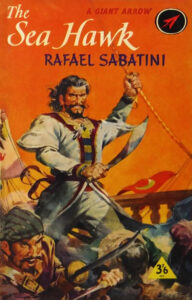 A theater poster for Rex Ingram’s 1923 film adaption of Rafael Sabitini’s Scaramouche.
A theater poster for Rex Ingram’s 1923 film adaption of Rafael Sabitini’s Scaramouche.
Published in 1932 by Houghton Mifflin Company, the first edition of The Black Swan used for its dust jacket art N. C. Wyeth’s painting for Rafael Sabatini’s short story, “The Duel on the Beach,” published in the September 1931 issue of Ladies’ Home Journal.
Closing out our post is James E. McConnel’s cover for the 1961 edition of Scaramouche, published in Great Britain by Pan Books, and the artist’s cover for The Sea Hawk, published in Great Brittain by Arrow in 1958.
The quote that ends our post is from Rafael Sabatini’s grave marker. It’s also the first line from Scaramouche, the author’s favorite novel from his oeuvre.
Derek Starr is a writer and popular culture enthusiast who began contributing to our website in 2022. He particularly enjoys the Fiction House pulps. One of his favorites is Planet Stories, the publisher’s legendary science fiction pulp. He’s also a fan of their air pulps and Action Stories and has a soft spot for historical fiction.

